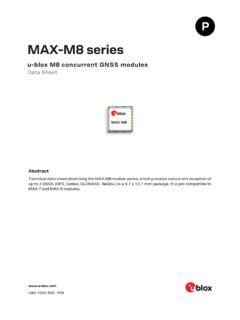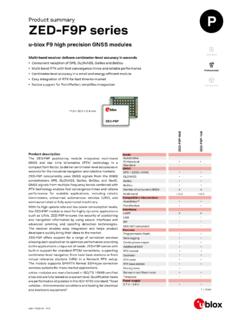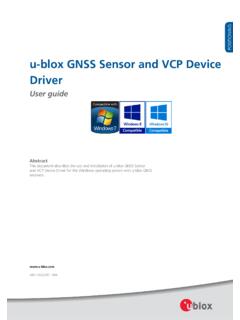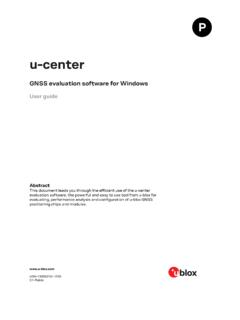Transcription of u-blox M8 concurrent GNSS modules
1 NEO-M8. u-blox M8 concurrent GNSS modules Data sheet Abstract This data sheet describes the NEO-M8 module family which provides concurrent reception of up to 3 GNSS. (GPS, Galileo, GLONASS, BeiDou). NEO-M8 is backward compatible with NEO-7, NEO-6 and NEO-5. families. UBX-15031086 - R11. C1-Public NEO-M8 - Data sheet Document information Title NEO-M8. Subtitle u-blox M8 concurrent GNSS modules Document type Data sheet Document number UBX-15031086. Revision and date R11 22-Oct-2021. Document status Production information Disclosure restriction C1-Public Product status Corresponding content status In Development / Objective Specification Target values. Revised and supplementary data will be published later. Prototype Engineering Sample Advance Information Data based on early testing. Revised and supplementary data will be published later. Initial Production Early Production Information Data from product verification. Revised and supplementary data may be published later.
2 Mass Production / Production Information Document contains the final product specification. End of Life This document applies to the following products: Product name Type number Firmware version PCN reference NEO-M8N NEO-M8N-0-12 Flash FW SPG UBX-21015025. NEO-M8Q NEO-M8Q-0-12 ROM SPG UBX-21015025. NEO-M8M NEO-M8M-0-11 ROM SPG UBX-21015022. NEO-M8J NEO-M8J-0-11 Flash FW SPG UBX-21015025. u-blox or third parties may hold intellectual property rights in the products, names, logos and designs included in this document. Copying, reproduction, modification or disclosure to third parties of this document or any part thereof is only permitted with the express written permission of u-blox . The information contained herein is provided as is and u-blox assumes no liability for its use. No warranty, either express or implied, is given, including but not limited to, with respect to the accuracy, correctness, reliability and fitness for a particular purpose of the information.
3 This document may be revised by u-blox at any time without notice. For the most recent documents, visit Copyright u-blox AG. UBX-15031086 - R11 Document information Page 2 of 29. C1-Public NEO-M8 - Data sheet Contents Document information .. 2. Contents .. 3. 1 Functional description .. 5. Overview .. 5. Product features .. 5. Performance .. 6. Block diagram .. 7. Supported GNSS constellations .. 7. GPS .. 7. GLONASS .. 8. BeiDou .. 8. Galileo .. 8. Assisted GNSS (A-GNSS) .. 8. AssistNowTM Online .. 8. AssistNowTM Offline .. 8. AssistNowTM Autonomous .. 9. Augmentation systems .. 9. satellite -based augmentation system (SBAS) .. 9. QZSS .. 9. IMES .. 9. Differential GPS (D-GPS) ..10. Broadcast navigation data and satellite signal measurements ..10. Odometer ..10. Data logging (NEO-M8N/J) ..10. Message integrity protection ..11. Spoofing detection ..11. EXTINT: External Pin control ..11. Aiding ..11. TIMEPULSE ..12. Protocols and interfaces.
4 12. Interfaces ..12. UART ..12. USB ..12. SPI ..12. Display data channel (DDC) ..13. Clock Oscillators ..13. Real-time clock (RTC) ..13. UBX-15031086 - Production information Contents Page 3 of 29. C1-Public NEO-M8 - Data sheet Power management ..13. DC-DC converter ..13. Power mode setup ..13. Continuous mode ..14. Power save mode ..14. Antenna ..14. LNA_EN ..14. 2 Pin definition .. 15. Pin assignment ..15. Pin name changes ..16. 3 Configuration management .. 17. Interface selection (D_SEL) ..17. 4 Electrical specification .. 18. Absolute maximum Operating conditions ..18. Indicative current requirements ..19. SPI timing diagrams ..20. Timing recommendations ..20. DDC timing diagrams ..20. 5 Mechanical specifications .. 21. 6 Reliability tests and 22. Reliability tests ..22. Approvals ..22. 7 Product handling and soldering .. 23. Packaging ..23. Reels ..23. Tapes ..23. Shipment, storage and handling ..24. Moisture sensitivity levels ..24.
5 Reflow soldering ..24. ESD handling precautions ..24. 8 Default messages .. 25. 9 Labeling and ordering information .. 26. Product Explanation of codes ..26. Ordering codes ..26. Appendix .. 27. A Glossary .. 27. Related documents .. 28. Revision history .. 28. Contact .. 29. UBX-15031086 - Production information Contents Page 4 of 29. C1-Public NEO-M8 - Data sheet 1 Functional description Overview The NEO-M8 series of concurrent GNSS modules is built on the high-performing u-blox M8 GNSS. engine in the industry-proven NEO form factor. The NEO-M8 modules utilize concurrent reception of up to three GNSS systems (GPS/Galileo together with BeiDou or GLONASS), recognize multiple constellations simultaneously and provide outstanding positioning accuracy in scenarios where urban canyon or weak signals are involved. For even better and faster positioning improvement, the NEO-M8 series supports augmentation of QZSS, GAGAN. and IMES together with WAAS, EGNOS, and MSAS.
6 The NEO-M8 series also supports message integrity protection, geofencing, and spoofing detection with configurable interface settings to easily fit to customer applications. The NEO M8M is optimized for cost-sensitive applications, while NEO-M8N and NEO-M8Q provide the best performance. The future-proof NEO-M8N and NEO-M8J include an internal flash that allows future firmware updates. This makes NEO-M8N and NEO-M8J perfectly suited to industrial and automotive applications. The I2C-compliant DDC interface provides connectivity and enables synergies with most u blox cellular modules . For RF optimization, NEO-M8J, NEO-M8N, and NEO-M8Q feature an additional front-end LNA for easier antenna integration and a front-end SAW filter for increased jamming immunity. u-blox M8 modules use GNSS chips qualified according to AEC Q100, are manufactured in ISO/TS. 16949 certified sites, and are fully tested on a system level. Qualification tests are performed as stipulated in the ISO16750 standard: Road vehicles Environmental conditions and testing for electrical and electronic equipment.
7 The u-blox NEO-M8 modules can also benefit from the u-blox AssistNow assistance service. The Online service provides GNNS broadcast parameters, for example, ephemeris, almanac plus time or rough position to reduce the receiver's time to first fix significantly and to improve acquisition sensitivity. The extended validity of AssistNow Offline data (up to 35 days) and AssistNow Autonomous data (up to 6 days) provide faster acquisition after a long off time. See section for more information concerning the NEO-M8 related AssistNow Assistance. Product features Model Category GNSS Supply Interfaces Features Grade Built-in antenna supply Number of concurrent Programmable (flash). High Precision GNSS. DDC (I2C compliant). Standard Precision Dead Reckoning Built-in antenna Additional SAW. Additional LNA. and supervisor V V. Data logging Professional V V. GPS / QZSS. Automotive RTC crystal Timepulse GLONASS. Oscillator Standard BeiDou Timing Galileo GNSS.
8 UART. USB. SPI. NEO-M8N 3 T 1 . NEO-M8Q 3 T 1 . NEO-M8M 3 C 1 . NEO-M8J 3 C 1 . C = Crystal / T = TCXO. UBX-15031086 - Production information Functional description Page 5 of 29. C1-Public NEO-M8 - Data sheet Performance Parameter Specification Receiver type 72-channel u-blox M8 engine GPS L1C/A, SBAS L1C/A, QZSS L1C/A, QZSS L1 SAIF, GLONASS L1OF, BeiDou B1I, Galileo E1B/C. Accuracy of time RMS 30 ns pulse signal 99% 60 ns Frequency of time Hz 10 MHz pulse signal (configurable). Operational limits 1 Dynamics 4g Altitude 50,000 m Velocity 500 m/s Velocity accuracy 2 m/s 2. Heading accuracy degrees GNSS GPS & GLONASS GPS GLONASS BeiDou Galileo Horizontal position m m 4m 3m 3m accuracy 3 With SBAS m m - - - NEO-M8N/Q. Max navigation NEO-M8N 5 Hz 10 Hz 10 Hz 10 Hz 10 Hz update rate NEO-M8Q 10 Hz 18 Hz 18 Hz 18 Hz 18 Hz Time-To-First-Fix 4 Cold start 26 s 29 s 30 s 34 s 45 s Hot start 1s 1s 1s 1s 1s 5. Aided starts 2s 2s 2s 3s 7s Sensitivity 6 Tracking & 167 dBm 166 dBm -166 dBm -160 dBm -159 dBm Navigation Reacquisition 160 dBm 160 dBm -156 dBm -157 dBm -153 dBm Cold start 148 dBm 148 dBm -145 dBm -143 dBm -138 dBm Hot start 157 dBm 157 dBm -156 dBm -155 dBm -151 dBm NEO-M8J/M.
9 Max navigation NEO-M8J 5 Hz 10 Hz 10 Hz 10 Hz 10 Hz update rate NEO-M8M 10 Hz 18 Hz 18 Hz 18 Hz 18 Hz Time-To-First-Fix 4 Cold start 26 s 30 s 33 s 39 s 57 s Hot start 1s 1s 1s 1s 1s Aided starts 6 3s 3s 3s 7s 7s 6. Sensitivity Tracking & -164 dBm -164 dBm -163 dBm -160 dBm -154 dBm Navigation Reacquisition -160 dBm -159 dBm -156 dBm -155 dBm -152dBm Cold start -148 dBm -147 dBm -145 dBm -143 dBm -133 dBm Hot start -157 dBm -156 dBm -155 dBm -155 dBm -151 dBm Table 1: NEO-M8 performance in different GNSS modes (default: concurrent reception of GPS and GLONASS including QZSS, SBAS). 1. Assuming Airborne < 4 g platform 2. 50% at 30 m/s 3. CEP, 50%, 24 hours static, -130 dBm, > 6 SVs 4. All satellites at -130 dBm, except Galileo at -127 dBm 5. Dependent on aiding data connection speed and latency 6. Demonstrated with a good external LNA. UBX-15031086 - Production information Functional description Page 6 of 29. C1-Public NEO-M8 - Data sheet Block diagram Figure 1: NEO-M8 block diagram Supported GNSS constellations The NEO-M8 GNSS modules are concurrent GNSS receivers which can receive and track multiple GNSS systems: GPS, Galileo, GLONASS and BeiDou.
10 Owing to the dual-frequency RF front-end architecture, either GLONASS or BeiDou can be processed concurrently with GPS and Galileo signals providing reception of three GNSS systems. By default the M8 receivers are configured for concurrent GPS and GLONASS, including SBAS and QZSS reception. If power consumption is a key factor, the receiver should be configured for a single GNSS operation using GPS, Galileo, GLONASS or BeiDou and disabling QZSS and SBAS. The module can be configured to receive any single GNSS constellation or within the set of permissible combinations shown below. GPS Galileo GLONASS BeiDou .. Table 2 Permissible GNSS combinations ( = enabled). The SBAS and QZSS augmentation systems can be enabled only if GPS operation is configured. Galileo is not enabled as the default configuration. GPS. The NEO-M8 positioning modules are designed to receive and track the L1C/A signals provided at MHz by the global positioning system (GPS).



